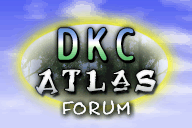Hello guys,
I'm currently working on a DKC 3 hack with SDK3 editor, and I would like to know if there is a way to change the introduction of the game as well as the title screen. As I have absolutely no programing skills, anyone could eventually help me ?
Thank you !!!
Custom title and intro
4 posts
• Page 1 of 1
Re: Custom title and intro
I imagine those are scripted, ie, programming knowledge required. However, you can use a tile editor to change the title like this: 
https://imgur.com/a/EzHw5P7
Also, any solid hex editor can change text, like this:
https://imgur.com/a/tXeqvqJ
I'm not good at embedding LOL

https://imgur.com/a/EzHw5P7
Also, any solid hex editor can change text, like this:

https://imgur.com/a/tXeqvqJ
I'm not good at embedding LOL
Re: Custom title and intro
The title tileset uses the "standard" tile compression in DKC2 and DKC3, so the encoder from the SDK2 editor should work in theory. The tilemap however uses another compression scheme specific to DKC3 for which no unofficial encoder exists as far as I know.
That's just the background though. The banner is separate:
The banner is also used on the music menu screen and in the photo album intro. The same notes about the compression apply here too and indeed to almost every non-scrolling screen in the game. The palette for the title screen is at 3D:7701.
The intro is split into a few distinct parts. The bouncing Rareware logo is Mode7 which has its own graphics format. Quaraage managed to change the Rareware logo in DKC2, but I wouldn't be surprised if the DKC3 version was buried under an additional 30 layers of ad-hoc compression formats. After that there are the scrolling thing and the 1996 Nintendo screens which follow the same single screen concepts as before.
Most text in DKC3 is compressed using yet another compression scheme, so it's not something you can play with in a hex editor. That includes level names and just about all dialogue. It's not something you'd think about, but the game contains a heck of a lot of text. I wouldn't be surprised if there were full blown RPGs on the SNES with less text than our glorious DKC3.
They really went all out with compression too, everything is packed so tight. Don't even get me started on banana bird palettes or bear cabin templates.
- Code: Select all
0C:FE3D - Title Screen Tileset
28:7581 - Title Screen Tilemap
That's just the background though. The banner is separate:
- Code: Select all
29:339E - Tilemap <-
29:342E - Tileset <- (sequential!)
The banner is also used on the music menu screen and in the photo album intro. The same notes about the compression apply here too and indeed to almost every non-scrolling screen in the game. The palette for the title screen is at 3D:7701.
The intro is split into a few distinct parts. The bouncing Rareware logo is Mode7 which has its own graphics format. Quaraage managed to change the Rareware logo in DKC2, but I wouldn't be surprised if the DKC3 version was buried under an additional 30 layers of ad-hoc compression formats. After that there are the scrolling thing and the 1996 Nintendo screens which follow the same single screen concepts as before.
rainbowsprinklez wrote:Also, any solid hex editor can change text
Most text in DKC3 is compressed using yet another compression scheme, so it's not something you can play with in a hex editor. That includes level names and just about all dialogue. It's not something you'd think about, but the game contains a heck of a lot of text. I wouldn't be surprised if there were full blown RPGs on the SNES with less text than our glorious DKC3.
They really went all out with compression too, everything is packed so tight. Don't even get me started on banana bird palettes or bear cabin templates.

Re: Custom title and intro
Kingizor wrote:rainbowsprinklez wrote:Also, any solid hex editor can change text
Most text in DKC3 is compressed using yet another compression scheme, so it's not something you can play with in a hex editor. That includes level names and just about all dialogue. It's not something you'd think about, but the game contains a heck of a lot of text. I wouldn't be surprised if there were full blown RPGs on the SNES with less text than our glorious DKC3.
They really went all out with compression too, everything is packed so tight. Don't even get me started on banana bird palettes or bear cabin templates.
Wow! I'm used to dkc1 (as you can no doubt see from my screenshots), where so little is compressed! Wow! I had no idea. Glad I'm not hacking THAT game
4 posts
• Page 1 of 1
Who is online
Users browsing this forum: No registered users and 14 guests
